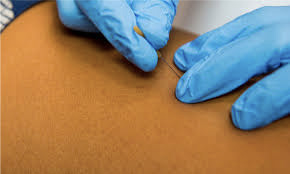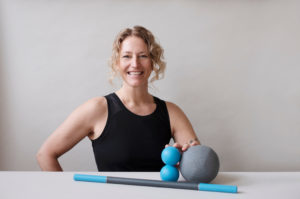3 Ways to Get Rid of Trigger Points
There are three basic ways for relieving trigger points in the tissues; manual trigger point therapy, dry needling, and self myofascial release.
1. Manual Trigger Point Therapy
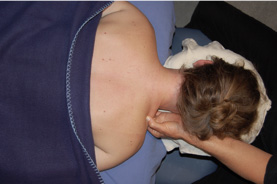
What is Manual Trigger Point Therapy?
Manual Trigger Point Therapy is a massage technique of compressing on trigger points to encourage them to go away, or soften. There are different opinions on what is the length of time to press on the point, should the recipient be active or passive in the process, and what to do after the treatment.
Let’s explore these methods.
How long should you press on the trigger point itself?
When I first studied trigger point therapy in the mid-90s, I took a course in the Bonnie Prudden Technique called MyoTherapy. Bonnie Prudden is the woman behind our nationalized standards of physical fitness and received trigger point injections by none other than Janet Travell, the Great Mother of trigger point therapy, herself! Bonnie would perform corrective exercises after receiving trigger point therapy and she developed her own hands-on version of the trigger point injection therapy, perhaps being the first manual trigger point therapist. Bonnie Prudden did a bunch of studies where she held the trigger points on her subjects for a variety of lengths of times: 5 seconds, 7 seconds, 15 seconds, a whole minute. What she determined by her research was that holding the trigger point 7 seconds was all it would take to relieve that spot. For the several years following my studies in her method I worked in the 7 second range for holding the points. I was very effective with helping my clients.
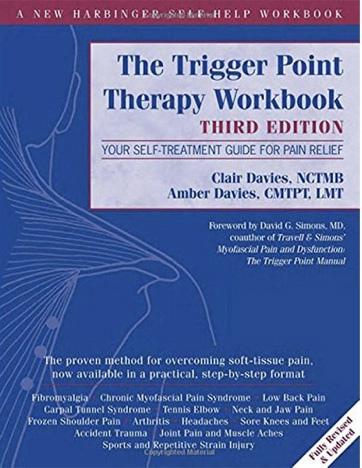
Fast forward to around 2012 and I took a course with Amber Davies who co-authored the book The Trigger Point Therapy Workbookwith her dad, Claire Davies. Amber taught us to hold the points longer, about 30 seconds to a minute, until we feel the tissue release. At this point in my career, I had been playing with holding points longer and working with the breathing patterns of my clients, finding that sometimes it seemed the points took longer to really release and I wanted to give the points more time to release. I wanted to feel that tissue soften under my pressure. So, I was excited to have that validated by Ms. Davies.
In 2017 I went up to study with Stew Wild at MyoPain Seminars. The folks at MyoPain seminars are very scientific in their approach to Trigger Point Therapy and run studies and research, mostly in the effects of dry needling. At the MyoPain Seminars clinic, they teach that you hold the point for up to about a minute and a half and you have the client actively move the muscle you are working on through some range of motion.
A Unique and Personalized Approach
Having worked with thousands of people, I have found that all of these techniques work to varying degrees from person to person and I like to offer a combination based on what I feel going on underneath my pressure. For some people, just holding one long breath seems to do the trick and their points release easily. These clients seem to have good hydration in their bodies, haven’t had the trigger points long, as is the case with a recent injury and not a chronic condition or due to chronic poor posture, and can really relax and breathe easily through the process. For them, 7 seconds will do the trick!
For some clients, their tissue needs a little longer to get the idea that I’m pressing here and it means to let that area go of its tension. Sometimes I hold compression for a minute, sometimes two minutes. Sometimes I ask them to just breathe and sink their bodies toward the earth while I hold the point. If after several breaths the point is still not softening, I will ask my client to start moving that muscle. This seems to help that tension spread more easily back to tone (a concept covered in my first BLOG post here) and the tender spot releases.
Regardless of the length of time the point is held or whether or not the recipient moves during the process, manual trigger point therapy is basically holding a point for a period of time with the intention of releasing the tension held there.
2. Dry Needling
What is Dry Needling of Trigger Points?
Dry needling is just like it sounds. A small acupuncture style needle is inserted into the trigger point. Painful? Yep. Effective? Sometimes amazingly so. Dry needling can be performed by a trained doctor or physical therapist. The practitioner maps out your trigger points based on your symptoms and their tests, and then inserts the little needle directly into the point. Sometimes the needle is removed and reinserted several times. Ouch! Sometimes the needle is gently turned while in the center of the trigger point. This method has been shown to be a very effective way, when done properly, to release trigger points.
I do have a hesitation with this method. What I have seen is that there are many doctors and PTs performing this work that don’t have the full extensive training required to really be effective. I suggest you ask your practitioner how much training and experience they have before letting them stick needles in you! Just my word of caution.
Where does the idea of dry needling come from?
Back in the Travell days, she used to inject the trigger points with an analgesic. At some point, a saline solution was used and then it turns out that it was more the act of the needle going into the point than what was being put into it! The injection of trigger points was a very effective method that got Dr. Janet Travell her position as the first female White House doctor under John F. Kennedy. JFK wanted to run for president but he had crippling pain and couldn’t walk, let alone embark on the rigorous travel schedule of someone running for the Oval Office. His family had tried everything (hey, they’re the KENNEDY’S! They COULD try everything!) and nothing helped until he was on the table at Dr. Travell’s office. When JFK got off the table after his first treatment he felt extraordinary relief for the very first time. He began working with Dr. Travell and eventually was able to run for, and be elected President of the United States. Sometimes Dr. Travell would travel with him and release his trigger points before he had to go out and give a speech. He said that her trigger point work enabled him to not only have his life back, but to be President.
3. Self Myofascial Release
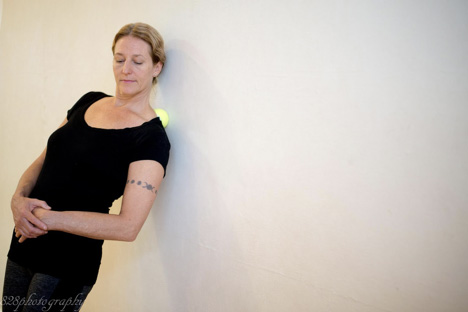
Can I release my trigger points myself?
Yes. Yes you can.
Using balls and foam rollers to release stuck tissues is often called Self MyoFascial Release, or SMFR. Most people who do this foam rolling are really just thinking about releasing their sticky fascia and hydrating their tissues. That’s all good. It gets even better when you layer in understanding of trigger point location and their pain referral patterns.
As a matter of fact, one of my teachers, Amber Davies, wrote that book mentioned above with her dad called The Trigger Point Therapy Workbook. That book is all about how to use a theracane, tennis balls, and the like to access and release the most common trigger points in the body. It is an extraordinary resource if you like to work on yourself.
For those of you who like to follow videos, I have created a YouTube channel with several free instructional videos on how to use therapeutic rolling or SMFR to release your own trigger points. Hooray! It’s empowering to have these tools in your toolkit so that you can take care of yourself.
Trigger points can be released by a practitioner through manual pressure or with dry needling. You can also release them yourself with a ball or other tool. Check out my YouTube channel and give it a try. You might be amazed at what you find you can do to help yourself feel well!
Read more:
Blog: What is a Trigger Point?
Blog: What Are The Symptoms of Trigger Points?


